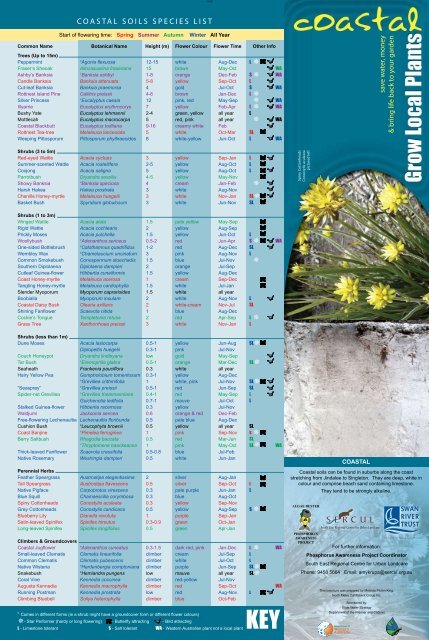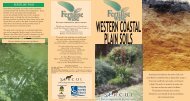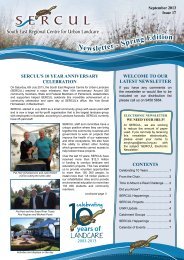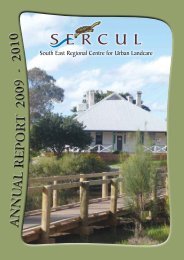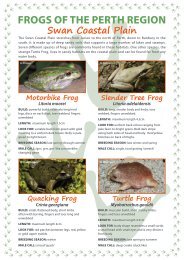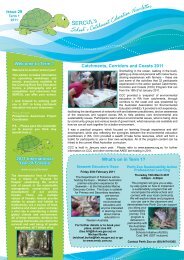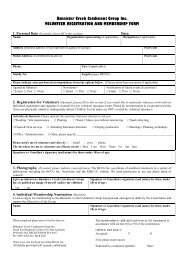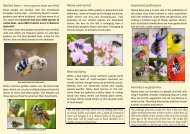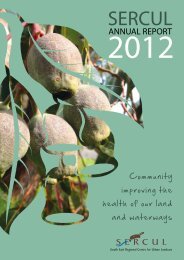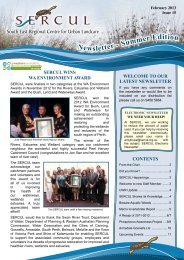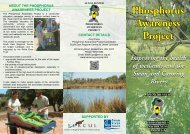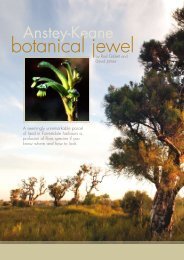You also want an ePaper? Increase the reach of your titles
YUMPU automatically turns print PDFs into web optimized ePapers that Google loves.
HEAD<br />
COASTAL SOILS SPECIES LIST<br />
Start of flowering time: Spring Summer Autumn<br />
Winter All Year<br />
Common Name Botanical Name Height (m) Flower Colour Flower Time Other Info<br />
Trees (Up to 15m)<br />
Peppermint °Agonis flexuosa 12-15 white Aug-Dec L <br />
Fraser’s Sheoak Allocasuarina fraseriana 15 brown May-Oct WA<br />
Ashby’s Banksia °Banksia ashbyi 1-8 orange Dec-Feb S WA<br />
Candle Banksia Banksia attenuata 5-8 yellow Sep-Oct L<br />
Cut-leaf Banksia Banksia praemorsa 4 gold Jul-Oct S WA<br />
Rottnest Island Pine Callitris preissii 4-6 brown Jan-Dec L <br />
Silver Princess °Eucalyptus caesia 12 pink, red May-Sep WA<br />
Illyarrie Eucalyptus erythrocorys 7 yellow Feb-Apr L WA<br />
Bushy Yate Eucalyptus lehmannii 2-4 green, yellow all year L<br />
Mottlecah Eucalyptus macrocarpa 5 red, pink all year WA<br />
<strong>Coastal</strong> Blackbutt Eucalyptus todtiana 9-16 creamy white Feb<br />
Rottnest Tea-tree Melaleuca lanceolata 5 white Oct-Mar SL<br />
Weeping Pittosporum Pittosporum phylliraeoides 8 white-yellow Jun-Oct L WA<br />
save water, money<br />
& bring life back to your garden<br />
Shrubs (3 to 5m)<br />
Red-eyed Wattle Acacia cyclops 3 yellow Sep-Jan L<br />
Summer-scented Wattle Acacia rostellifera 2-5 yellow Aug-Oct L<br />
Coojong Acacia saligna 5 yellow Aug-Oct L<br />
Parrotbush Dryandra sessilis 4-5 yellow May-Nov<br />
Showy Banksia °Banksia speciosa 4 cream Jan-Feb <br />
Harsh Hakea Hakea prostrata 3 white Aug-Nov<br />
Chenille Honey-myrtle Melaleuca huegelii 3 white Nov-Jan SL <br />
Basket Bush Spyridium globulosum 3 white Jun-Nov SL<br />
Spiny Cottonheads<br />
Conostylis aculeata<br />
pictured left<br />
Shrubs (1 to 3m)<br />
Winged Wattle Acacia alata 1.5 pale yellow May-Sep<br />
Rigid Wattle Acacia cochlearis 2 yellow Aug-Sep<br />
Prickly Moses Acacia pulchella 1.5 yellow Jun-Oct L<br />
Woollybush °Adenanthos sericeus 0.5-2 red Jun-Apr S WA<br />
One-sided Bottlebrush °Calothamnus quadrifidus 1-2 red Aug-Dec SL<br />
Wembley Wax °Chamelaucium uncinatum 3 pink Aug-Nov L<br />
Common Smokebush Conospermum stoechadis 1.5 blue Jul-Nov <br />
Southern Diplolaena Diplolaena dampieri 2 orange Jul-Sep<br />
Cutleaf Guinea-flower Hibbertia cuneiformis 1.5 yellow Aug-Dec<br />
Coast Honey-myrtle Melaleuca acerosa 1 cream Sep-Dec<br />
Tangling Honey-myrtle Melaleuca cardiophylla 1.5 white Jul-Jan<br />
Slender Myoporum Myoporum caprarioides 1.5 white all year<br />
Boobialla Myoporum insulare 2 white Aug-Nov L<br />
<strong>Coastal</strong> Daisy Bush Olearia axillaris 2 white-cream Nov-Jul SL<br />
Shining Fanflower Scaevola nitida 1 blue Aug-Dec<br />
Cockie’s Tongue Templetonia retusa 2 red Apr-Sep L <br />
Grass Tree Xanthorrhoea preissii 3 white Nov-Jan L<br />
Shrubs (less than 1m)<br />
Dune Moses Acacia lasiocarpa 0.5-1 yellow Jun-Aug SL <br />
Diplopeltis huegelii 0.3-1 pink Jul-Nov<br />
Couch Honeypot Dryandra lindleyana low gold May-Sep<br />
Tar Bush °Eremophila glabra 0.5-1 orange Mar-Dec SL <br />
Seaheath Frankenia pauciflora 0.3 white all year<br />
Hairy Yellow Pea Gompholobium tomentosum 0.3-1 yellow Aug-Dec<br />
°Grevillea crithmifolia 1 white, pink Jul-Nov SL <br />
“Seaspray” °Grevillea preissii 0.5-1 red Jun-Sep SL<br />
Spider-net Grevillea °Grevillea thelemanniana 0.4-1 red May-Sep L<br />
Guichenotia ledifolia 0.7-1 mauve Jul-Oct L<br />
Stalked Guinea-flower Hibbertia racemosa 0.3 yellow Jul-Nov<br />
Waldjumi Jacksonia sericea 0.6 orange & red Dec-Feb<br />
Free-flowering Lechenaultia Lechenaultia floribunda 0.5 pale blue Aug-Dec<br />
Cushion Bush °Leucophyta brownii 0.5 yellow all year SL<br />
Coast Banjine °Pimelea ferruginea 1 pink Sep-Nov S <br />
Berry Saltbush Rhagodia baccata 0.5 red Mar-Jun SL<br />
°Thryptomene baeckeacea 1 pink May-Oct SL WA<br />
Thick-leaved Fanflower Scaevola crassifolia 0.5-0.8 blue Jul-Feb<br />
Native Rosemary Westringia dampieri 0.5 white Jun-Jan<br />
Perennial Herbs<br />
Feather Speargrass Austrostipa elegantissima 2 silver Aug-Jan<br />
Tall Speargrass Austrostipa flavescens 0.5 silver Sep-Oct L<br />
Native Pigface Carpobrotus virescens 0.3 pale purple Jun-Jan L<br />
Blue Squill Chamaescilla corymbosa 0.3 blue Aug-Oct<br />
Spiny Cottonheads Conostylis aculeata 0.3 yellow Sep-Nov<br />
Grey Cottonheads Conostylis candicans 0.5 yellow Aug-Sep S <br />
Blueberry Lily Dianella revoluta 1 purple Sep-Jan<br />
Satin-leaved Spinifex Spinifex hirsutus 0.3-0.9 green Oct-Jan<br />
Long-leaved Spinifex Spinifex longifolius 0.5 green Apr-Jan<br />
Climbers & Groundcovers<br />
<strong>Coastal</strong> Jugflower °Adenanthos cuneatus 0.3-1.5 dark red, pink Jan-Dec L WA<br />
Small-leaved Clematis Clematis linearifolia climber cream Jul-Sep L<br />
Common Clematis Clematis pubescens climber white Jul-Oct L<br />
Native Wisteria °Hardenbergia comptoniana climber purple Jun-Sep SL <br />
Snakebush °Hemiandra pungens low mauve all year SL <br />
Coral Vine Kennedia coccinea climber red-yellow Jul-Nov<br />
Augusta Kennedia Kennedia macrophylla climber red Sep-Oct WA<br />
Running Postman Kennedia prostrata low red Aug-Nov L<br />
Climbing Bluebell Sollya heterophylla climber blue Oct-Feb<br />
° Comes in different forms (ie a shrub might have a groundcover form or different flower colours)<br />
- Star Performer (hardy or long flowering) - Butterfly attracting - Bird attracting<br />
L - Limestone tolerant S - Salt tolerant WA - Western Australian plant not a local plant KEY<br />
COASTAL<br />
<strong>Coastal</strong> soils can be found in suburbs along the coast<br />
stretching from Jindalee to Singleton. They are deep, white in<br />
colour and comprise beach sand containing limestone.<br />
ALGAE BUSTER<br />
PHOSPHORUS<br />
AWARENESS<br />
PROJECT<br />
They tend to be strongly alkaline.<br />
For further information:<br />
Phosphorus Awareness Project Coordinator<br />
South East Regional Centre for Urban Landcare<br />
Phone: 9458 5664 Email: amykrupa@sercul.org.au<br />
This brochure was prepared by Melinda Picton-King,<br />
North Metro Catchment Group Inc.<br />
Sponsored by:<br />
State Water Strategy<br />
Department of the Premier and Cabinet<br />
Caring for the Swan Canning Riverpark
HEAD<br />
WHAT ARE LOCAL PLANTS<br />
<strong>Local</strong> plants are species that would naturally<br />
occur in your neighbourhood and are<br />
therefore adapted to the local<br />
climate and soil.<br />
GROW LOCAL PLANTS<br />
There are a huge range of local<br />
WA plants that can be used to create<br />
many contemporary garden styles such<br />
as cottage, formal, Mediterranean and<br />
bushland. Be creative with local plants and<br />
use them in hanging baskets and containers, as<br />
hedges and as topiary.<br />
Garden Design Tips<br />
• Plan your garden design on graph paper.<br />
• Think about areas of usage (eg eating areas, play areas) and<br />
incorporate these into your garden design.<br />
• Keep in mind views from the house<br />
(eg retain good views and use plants to hide eyesores).<br />
• <strong>Plant</strong> trees at least 3m from fences and walls so their growth isn’t<br />
hampered and they don’t become a nuisance.<br />
• Make sure you prepare the site and remove all weeds prior to<br />
mulching or planting.<br />
• You can use local plants in your whole garden, in a garden bed<br />
or mixed in with exotics.<br />
• Group plants with similar water and fertiliser requirements<br />
together, especially if mixing local plants with exotics.<br />
• Keep in mind the growing requirements of plants (eg don’t plant a<br />
sun loving plant in the shade of a larger shrub).<br />
• Be aware that there are different forms of plants you can use in<br />
your garden (eg dwarf forms of trees and groundcover forms of<br />
many shrubs).<br />
• Select plants that flower in each season to provide colour in your<br />
garden all year round.<br />
• Use a diverse range of plants but repeat themes of plants and<br />
place them in groups of uneven numbers for greater impact.<br />
• Vary the height layers in your garden to add interest and<br />
habitat. (eg tree canopy, shrubs, groundcovers).<br />
• Think of your garden like a room in your house and plant in stages.<br />
Lay the carpet (groundcovers) in first, then place the furniture<br />
(theme shrubs and trees) and then dress the room with the<br />
smaller flowering shrubs and feature plants.<br />
• Continually review your design and keep complementing your<br />
garden with new plants. Think of your garden as progressive and<br />
ever changing to be built upon over time.<br />
PLANT SELECTION & PLANTING OUT<br />
• Buy plants local to your area or suited to your soil type (see list).<br />
• Buy small plants in bigger pots as they aren’t root bound and<br />
better establish in the garden. You can buy some larger feature<br />
plants for a more instant effect.<br />
• Always read the labels to check the size of the plant when<br />
mature to be sure that you are getting the desired plant form.<br />
• <strong>Coastal</strong> plants will grow inland, but inland plants don’t grow well<br />
on the coast.<br />
• Don’t choose plants that are environmental weeds.<br />
• <strong>Plant</strong> in late April or May after the first good autumn rains, as<br />
plants have more time to establish before summer.<br />
WA PLANT NURSERIES<br />
Different nurseries have varying ranges of WA plants so you might need<br />
to shop around. If you really want a particular selection of plants, then it<br />
is a good idea to order ahead in about September so the plants can be<br />
grown ready for planting in autumn. Some specialist local nurseries are:<br />
APACE Nursery: 1 Johanna St, NORTH FREMANTLE<br />
Carramar <strong>Coastal</strong> Nursery: Lot 5 885 Mandurah Rd,<br />
SECRET HARBOUR<br />
Lullfitz Nursery: Caporn St (cnr Honey Rd), WANNEROO<br />
1071 Thomas Road, OAKFORD<br />
Men of the Trees: Cnr Amherst Rd/Stirling Cr, HAZELMERE<br />
Rockingham Golf Club, Elanora Dr, COOLOONGUP<br />
Muchea Tree Farm: Lot 214 Archibald St, MUCHEA<br />
Australian Native<br />
Nurseries Group: 141 King Rd, OAKFORD<br />
Zanthorrea Nursery: 155 Watsonia Rd, MAIDA VALE<br />
WATERING<br />
WA plants are adapted to our dry climate and low rainfall - they are used<br />
to a bit of stress and in fact need this to perform their best. Overwatering<br />
leads to shorter lived plants with excessive growth and less prolific<br />
flowering. An excess of water leads to leaching of nutrients from sandy<br />
soils and encourages diseases that can lead to fatal root rot.<br />
Remember the aim is to encourage plants to grow strong root systems,<br />
which makes them more water efficient and drought tolerant. To keep<br />
your garden looking its best, it may be desirable to give some plants a<br />
supplementary watering over summer.<br />
When to water (always follow water restrictions)<br />
For new plants water:<br />
• Once or twice a week in the first few weeks after planting.<br />
• Once or twice a week in the summer period for the first 1-2 years<br />
until plants are established (generally from about November to May<br />
until the first good rain occurs).<br />
For established plants water:<br />
• When there is a heat wave<br />
• When the soil under the surface is dry<br />
• When signs of stress are apparent (eg wilting, dull foliage colour,<br />
leaf shrinkage)<br />
In general the watering regime for mature plants varies with the soil<br />
type, origin of the plant, season and natural rainfall.<br />
What irrigation to use<br />
WA plants like the soil surface to remain dry and many are sensitive to<br />
overhead watering (eg sprinklers, misters). Thus the best irrigation to<br />
use is adjustable dripper/trickle systems or subsurface irrigation.<br />
Watering tips<br />
• Watering in the morning is preferable as moisture sitting on plant<br />
leaves and stems overnight can cause plant diseases.<br />
• Avoid watering only the soil surface layer as this encourages<br />
shallow roots making plants more susceptible to drying out and<br />
blowing over. Longer deeper watering encourages the growth<br />
of deeper, more stable roots.<br />
• If water repellence occurs, apply a wetting agent.<br />
• Use a dripper with a high flow rate for water demanding plants<br />
eg Boronia, Scaevola.<br />
Grevillea crithmifolia Acacia lasiocarpa Calothamnus quadrifidus Hakea prostrata Kennedia prostrata<br />
PRUNING<br />
To keep WA plants looking their best, it is necessary to do some pruning<br />
to help keep the plant in shape and promote flowering.<br />
When to prune<br />
In general prune after flowering has finished in late spring or early<br />
summer. Avoid pruning in winter or mid summer, as this may cause<br />
plants to die back extensively. It is better to prune young plants lightly<br />
and regularly. Older plants can be rejuvenated by more extensive<br />
pruning after flowering.<br />
How to prune<br />
There are two main types of plant flowering habits each requiring<br />
different pruning methods:<br />
1. <strong>Plant</strong>s that flower on the end of each season’s growth –<br />
trim off the flowering stems from behind the seed capsules after the<br />
plant has finished flowering. Regular pruning prevents these plants<br />
from becoming straggly. Eg Callistemon (Bottlebrush), Pimelea.<br />
2. <strong>Plant</strong>s that flower on old wood – remove the oldest wood from the<br />
centre of the plant, letting the younger wood remain.<br />
Eg some species of Melaleuca.<br />
Tips for pruning<br />
• Cut off the whole branch cleanly at the join leaving no<br />
protruding stump.<br />
• Remove low branches to make weeding easier.<br />
• Use chopped up prunings as mulch.<br />
• Only prune the softer wooded plants (eg large wattles) lightly as they<br />
aren’t as hardy as the woodier plants and tend to die back extensively.<br />
• Eucalypts, Callistemons and Melaleucas respond well to pruning<br />
and can tolerate a hard prune.<br />
• Cut back Kangaroo Paws to the ground after flowering each year.<br />
It helps prevent black ink disease and promotes better growth.<br />
MULCH<br />
Good mulch consists of a mixture of different sized materials such as<br />
leaves, twigs and bark, lets water easily penetrate through to the soil<br />
and prevents evaporation. The mulch materials shouldn’t absorb too<br />
much water, otherwise they make less available to the plants.<br />
The best mulch<br />
• Groundcovers and natural leaf litter formed by the plants in<br />
your garden.<br />
• Street tree loppings – may contain some weeds but they are easily<br />
seen and removed.<br />
• Inert materials (eg gravel, crushed brick) are particularly good in<br />
windy areas as they don’t blow around.<br />
How much mulch<br />
Apply mulch about 5cm thick, creating a bowl shape around the plant to<br />
aid water retention.<br />
What to avoid:<br />
• Avoid layering mulch too thickly as this can impede water infiltration<br />
and reduce plant survival.<br />
• Avoid mulching too close to the stem of the plant as the constant<br />
humidity encourages plant diseases and WA plants prefer the<br />
surrounding soil surface to be dry.<br />
• Avoid using sawdust and raw wood products (eg wood chips) as<br />
they can interfere with iron uptake, draw nitrogen out of the soil and<br />
cause the soil to become water repellent. Always compost woody<br />
mulches for at least 6 months before use.<br />
• Avoid using mulch from soft leaved plants like many exotic species,<br />
as it decays too fast and releases too many nutrients for WA plants.<br />
• Avoid some packaged mulches as they contain high levels of<br />
nitrogen and phosphorus which isn’t suitable for WA plants.<br />
FERTILISERS<br />
As WA plants are adapted to soils that are low in nutrients they<br />
usually don’t require fertiliser. In a garden situation you can apply a<br />
little fertiliser to keep plants looking perfect, but be cautious as some<br />
species are sensitive to fertilisers, particularly phosphorus. Sufficient<br />
phosphorus is naturally present in the soil.<br />
When to apply<br />
Apply fertiliser when planting by mixing into the soil at the bottom of<br />
the hole. Subsequent fertilising should be done on the surrounding root<br />
zone only when nutrient deficiency is apparent and only when plants<br />
are actively growing in spring.<br />
What fertiliser to use<br />
(Note: always follow the manufacturer instructions on dosage and application)<br />
• Slow release fertilisers for native plants.<br />
• Low phosphorus and low nitrogen fertilisers.<br />
• Fish emulsion or seaweed fertiliser to boost plants immunity<br />
to disease.<br />
What not to fertilise<br />
• Some plants are highly sensitive to fertilisers, particularly<br />
fertilisers that contain phosphorus.<br />
Eg: Banksias, Grevilleas, Dryandras,<br />
Hakeas (Proteaceae family).<br />
• Don’t overfertilise Everlastings as they get too tall<br />
and weak and lie down when flowering.<br />
When to mulch<br />
Organic mulches need renewing seasonally as they break down over<br />
time, but are best applied at the start of warmer weather in spring and<br />
early summer.<br />
REFERENCES<br />
For more information refer to<br />
A New Image for WA <strong>Plant</strong>s - George Lullfitz,<br />
<strong>Grow</strong> With Us - Wildflower Society of WA,<br />
<strong>Grow</strong>ing <strong>Local</strong>s - Robert Powell.


